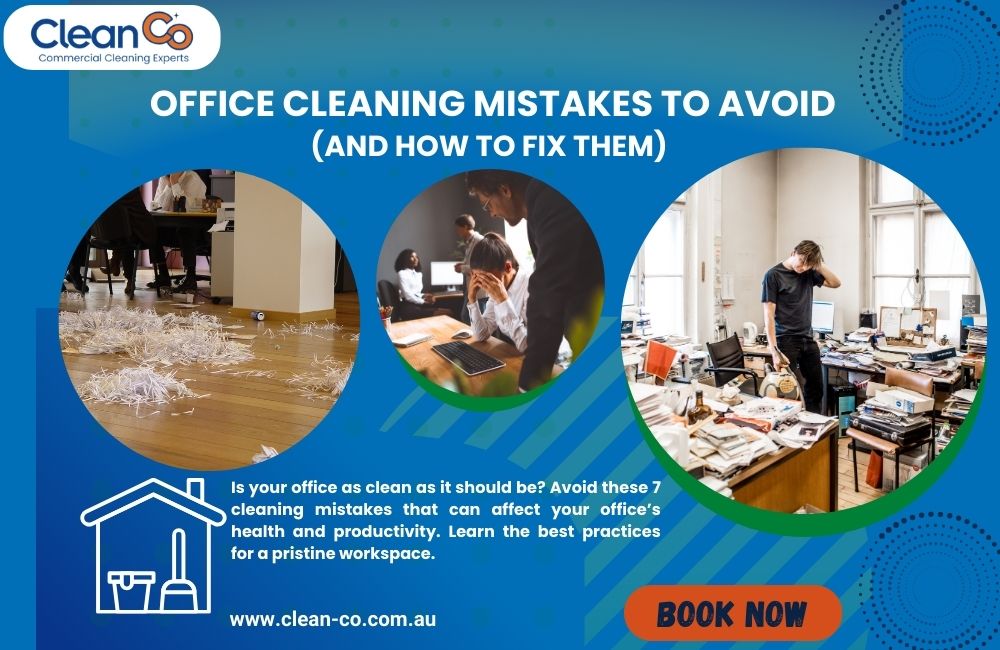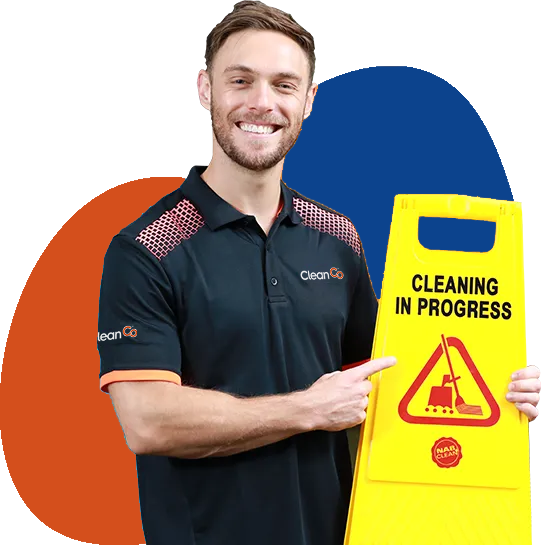Maintaining a clean office environment is crucial for the success of any business. A well-kept office not only boosts employee morale and productivity but also creates a professional image for clients and visitors. Clean spaces contribute to better health by minimizing the spread of germs and allergens, which is essential for any workplace, especially in shared areas. Neglecting proper office cleaning, however, can lead to negative outcomes, including reduced productivity, increased absenteeism, and even damage to office equipment and furniture.
7 common office cleaning mistakes to avoid to ensure a clean, healthy, and productive workspace for everyone.
- Using the wrong cleaning products – Can damage surfaces and equipment; always choose product-specific cleaners.
- Neglecting high-touch surfaces – Failing to clean items like keyboards and door handles spreads germs and illness.
- Infrequent deep cleaning – Skipping regular deep cleans allows hidden dirt and allergens to accumulate.
- Poor trash management – Overflowing or unsorted trash attracts pests and causes odors.
- Ignoring air vents and HVAC systems – Dirty systems reduce air quality and spread dust.
- Overlooking cleaning of office equipment – Dust and grime build up on devices like printers and phones if ignored.
- Lack of a cleaning schedule – Without a consistent plan, cleanliness suffers and tasks are missed.
Mistake #1: Using the Wrong Cleaning Products
One of the most common mistakes people make when cleaning their office is using the wrong cleaning products. Many office managers and cleaning staff often pick the first product they find without considering the specific needs of the surfaces they’re cleaning. Not all cleaning products are created equal, and using the wrong one can result in damage to your furniture, electronics, or even contribute to a buildup of harmful chemicals in the air.
Common Misconceptions About Cleaning Products:
- Some cleaners are marketed as “all-purpose” but are too harsh for sensitive surfaces like wood or leather.
- Products with strong chemical fragrances may give the illusion of cleanliness, but they may not actually disinfect or clean effectively.
- Bleach and other harsh chemicals can damage delicate surfaces and leave long-lasting fumes.
The Risks of Using Harsh Chemicals:
Using products with toxic chemicals or harsh abrasives can damage your office furniture, such as desks, chairs, and countertops. For example, using bleach on a wooden desk can cause discoloration, and strong chemicals may strip protective coatings off metal or plastic office furniture. These products may also leave harmful residues that can irritate employees with respiratory conditions.
How to Choose the Right Cleaning Supplies:
To avoid these issues, always select cleaning products that are designed for specific surfaces. For example:
- Use pH-balanced cleaners for wood surfaces.
- Opt for microfiber cloths to avoid scratching delicate items like computer screens.
- Choose eco-friendly, non-toxic cleaning products to ensure a healthier office environment. These cleaners are effective and safer for both employees and the planet.
Mistake #2: Overlooking High-Touch Surfaces
High-touch surfaces are areas that are frequently touched by multiple people throughout the day, such as door handles, light switches, phones, keyboards, and elevator buttons. These surfaces are breeding grounds for germs and bacteria, making them some of the most critical areas to clean regularly.
Why They Need More Frequent Cleaning:
In any office, high-touch surfaces come into contact with many hands throughout the day. This makes them prime sources for transferring germs and viruses, especially during cold and flu seasons. If not cleaned regularly, these surfaces can harbor harmful bacteria and viruses, putting the health of your employees and visitors at risk.
Tips for Disinfecting High-Touch Areas Effectively:
- Disinfect high-touch surfaces multiple times a day, particularly during cold and flu season.
- Use disinfectant wipes or sprays that are specifically designed for high-traffic areas.
- Ensure all employees are aware of the importance of cleaning their own workspace, especially when using shared items like phones, keyboards, and conference room equipment.
Mistake #3: Ignoring the Office Air Quality
Clean air is often overlooked in discussions about office cleanliness, but it plays a significant role in maintaining a healthy and productive workspace. Poor indoor air quality can lead to health issues like headaches, dizziness, and fatigue, reducing employee productivity and overall satisfaction.
How Clean Air Affects Health and Productivity:
Studies show that poor air quality in the office can have a direct impact on productivity. Employees working in spaces with high levels of dust, allergens, and poor ventilation report feeling fatigued and are more likely to experience respiratory problems. Clean air can help improve focus, reduce absenteeism, and create a more pleasant work environment.
Common Mistakes That Impact Air Quality:
- Neglecting to change HVAC filters regularly, which can allow dust, mold, and allergens to circulate.
- Not cleaning air ducts and vents, which accumulate dust and debris over time.
- Using cleaning products that release harmful chemicals into the air, worsening air quality.
Solutions for Maintaining Good Air Quality:
- Regularly replace air filters and clean HVAC systems to ensure clean airflow throughout the office.
- Encourage ventilation by opening windows when possible, or consider investing in air purifiers for high-traffic areas.
- Use eco-friendly, non-toxic cleaning supplies that will not release harmful fumes into the air.
Mistake #4: Skipping Regular Deep Cleans
While surface cleaning is important, it’s essential not to skip regular deep cleaning sessions to address areas that are often neglected in daily cleaning routines. These deep cleans help maintain the overall appearance and hygiene of the office and prevent the buildup of dirt, dust, and grime in hard-to-reach areas.
The Difference Between Surface Cleaning and Deep Cleaning:
Surface cleaning may involve wiping down desks, vacuuming carpets, and taking out the trash. Deep cleaning, on the other hand, involves a more thorough cleaning of areas that don’t receive daily attention, such as baseboards, behind furniture, blinds, and windows.
Common Areas Often Missed in Routine Cleanings:
- Behind office furniture: Dust and dirt accumulate behind desks, chairs, and filing cabinets.
- Air vents and ducts: Over time, dust and debris can clog air vents and ducts, affecting airflow and air quality.
- Restrooms and kitchens: While frequently cleaned, these areas require more detailed sanitation to prevent the buildup of germs and mold.
When and How to Schedule Deep Cleans:
A good rule of thumb is to schedule a deep cleaning every quarter, though certain areas may need attention more often. Hiring a professional cleaning service ensures that all aspects of your office are thoroughly cleaned, from carpets to light fixtures. Make deep cleaning a priority to maintain a healthier and more efficient workspace.
Mistake #5: Not Cleaning Office Equipment
Office equipment like computers, printers, and phones can accumulate dust, dirt, and germs over time, affecting their performance and longevity. Many office managers neglect these items in their cleaning routines, which can lead to malfunctioning equipment and potential downtime.
Why Cleaning Equipment Is Crucial:
Dust and dirt buildup can cause office equipment to overheat, reducing efficiency and even leading to expensive repairs. Keyboards and phones are also hotbeds for bacteria and viruses, especially if they are shared among multiple people.
Common Mistakes with Cleaning Electronics and Office Machines:
- Using the wrong cleaning tools: Harsh chemicals or abrasive materials can damage screens or leave streaks on your devices.
- Not cleaning regularly: A quick dusting of office equipment can significantly extend the lifespan of these devices.
- Overlooking cords and wires: These areas can accumulate dust, making it harder to keep workstations neat and tidy.
Best Practices for Cleaning Key Office Equipment:
- Use microfiber cloths to clean screens, keyboards, and other electronics.
- For keyboards, turn them upside down to shake out debris, then use compressed air to blow out dust.
- Avoid using harsh chemicals and instead use a cleaner specifically designed for electronics.
Mistake #6: Failing to Create a Cleaning Schedule
A one-time office cleaning isn’t enough. Maintaining a clean office requires a regular cleaning schedule to ensure that all areas are consistently maintained. Without a structured cleaning routine, certain areas will quickly become neglected, leading to a decrease in cleanliness and overall hygiene.
The Importance of Routine Office Cleaning:
Routine cleaning ensures that the office remains consistently clean and organized. It prevents the buildup of dust, dirt, and germs, making it easier to maintain a healthy and safe environment. A cleaning schedule helps reduce the workload of cleaning staff and ensures that important areas are cleaned regularly.
How to Build an Effective Cleaning Schedule:
- Create a checklist for daily, weekly, and monthly cleaning tasks.
- Schedule regular office cleaning sessions, with more frequent cleaning for high-traffic areas.
- Prioritize areas like bathrooms, kitchens, and high-touch surfaces for daily attention.
Tips for Assigning Responsibilities:
- Assign specific cleaning tasks to employees to maintain their individual workspaces.
- If you’re outsourcing your office cleaning, ensure that your professional cleaning company understands your needs and the areas that require the most attention.
Mistake #7: Neglecting Employee Involvement
A clean office isn’t just the responsibility of the cleaning staff—it’s everyone’s job. Employees should be involved in maintaining cleanliness by following good hygiene practices and keeping their own work areas tidy.
Why Employees Should Be Part of the Cleaning Process:
When employees take responsibility for their own workspaces and shared spaces, it creates a more collaborative and efficient office environment. It also reinforces a sense of ownership over the cleanliness of the space, making the entire office cleaner overall.
Educating Employees About Proper Hygiene:
Provide employees with guidelines for cleaning their personal workstations, such as wiping down keyboards, disinfecting phones, and storing food properly. You can also create a cleaning protocol that encourages employees to clean up shared spaces like kitchens, meeting rooms, and bathrooms.
Creating a Clean Office Culture Together:
Encourage employees to participate in regular cleaning initiatives, like organizing quarterly cleaning days or challenges. These initiatives promote team building and contribute to a sense of pride in the workplace.
Conclusion
To sum up, maintaining a clean office is essential for promoting employee well-being, improving productivity, and enhancing your company’s image. By avoiding these seven common office cleaning mistakes, you can create a healthier, more organized, and more efficient workspace. Regular cleaning and maintaining a proactive cleaning schedule will not only improve hygiene but also extend the life of your office equipment and furniture.
If you want to take your office cleanliness to the next level, Clean Co offers professional cleaning services tailored to your needs. Reach out to us today and let us help you create a spotless, productive work environment.


